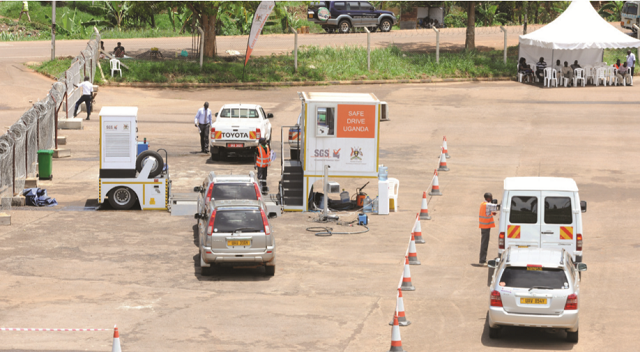
Is the mandatory vehicle inspection exercise manned by multinational company, SGS worth it for Uganda?
With two months to the date of apprehending motor vehicles that have not gone through mandatory vehicle inspection exercise, only 5,000 units out of over 800,000 motor vehicles on the road have been inspected as of March 23.
Out of the 5, 000, only 78% had passed the roadworthiness test that began in November last year, officials manning the exercise told The Independent in an interview. These numbers exclude motorcycles that are yet to be inspected for the same exercise.
In an interview with The Independent on March 23, the Minister for Works and Transport, Monica Azuba Ntege admitted that the numbers recorded so far are disappointing.
“I would have expected more…but you know very well that Ugandans do things at the last moment,” Ntege said, “But we hope that the public understands the exercise and embraces it.”
The mandatory exercise is about determining the technical condition of motor vehicles in the country so they comply with the traffic and road safety (Motor Vehicle inspection) regulations of 2016 and the standards set by the ministry of works and transport in the “Manual of Vehicle Inspection” as well as other recognised international road-safety standards.
Based on this legal frame work, vehicle owners will be penalised if they drive without a valid Vehicle Inspection Certificate, issued from the service operator SGS Automotive Uganda Limited starting June this year.
In cases where vehicles fail the test, owners must repair them and take them back for re-testing within a period of 30 days.
Many countries across the globe are enforcing this exercise in a bid to eliminate vehicles in dangerous mechanical conditions, which many times cause accidents. The exercise also reduces air pollution from vehicles that are old.
Currently, officials say the largest inspection centre – Kawanda has the capacity to test 200 vehicles in a day. There is another centre at Namboole. Other stations that are being prepared for the exercise and could open soon include Namulanda on Entebbe Road, Nabbingo on Masaka Road, and Namanve on Jinja Road. An additional three stations are being worked on in Gulu, Mbale and Mbarara. Three mobile inspection trucks are being assembled to serve areas with sparse vehicle population, according to SGS officials.
The inspection exercise largely covers the braking system, wheel alignment, exhaust smoke, headlamps and motor vehicle suspension among other conditions of the motor vehicle. All items inspected must be beyond 50% to accuracy for a vehicle to pass the test.
For Uganda, this is the second time the exercise is being implemented after nearly two decades since it was suspended. Before its suspension in 1998, the inspection was conducted by the Motor Vehicle Inspection unit of the Uganda police.
Currently it is being manned by the Swiss company, SGS, which provides inspection, verification, testing and certification services – under a public private partnership with government of Uganda under a contract of five years.
Minister Ntege said under the contract, SGS is charged with putting in place the necessary infrastructure while the government is supposed to ensure strict adherence to these guidelines (by both SGS and vehicle owners) by conducting regular monitoring and evaluation of the programme’s performance. She said government gets 10% of the revenue collected per month as concession fee while the balance remains with SGS to manage the entire exercise.
It costs Shs54, 752 for one to test one unit of motorcycle and a maximum of up to Shs 147, 500 for other categories of vehicles inclusive of value added tax. All private vehicles will be subject to inspection once every 12 months, while commercial vehicles will require inspection once every six months.
All vehicles are supposed to undergo the process except for private vehicles which are exempted from inspection for up to two years from the 1st of January of the year of manufacture.
This exemption, however, does not apply to commercial vehicles licensed by Transport Licensing Board.
 The Independent Uganda: You get the Truth we Pay the Price
The Independent Uganda: You get the Truth we Pay the Price




How many commercial vehicles can a persin avail in day e. g if the company has a large fleet?